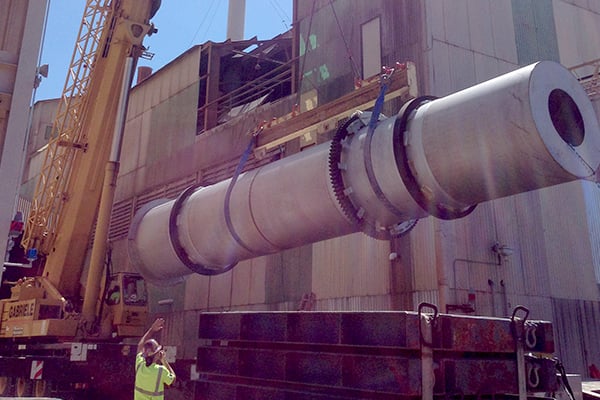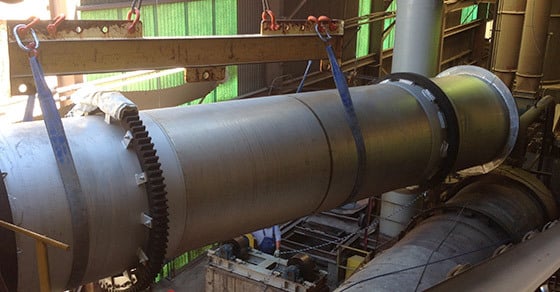While plant managers weigh many considerations in assessing rotary drum repair or replacement in their production line, one often-forgotten aspect that is pivotal to the decision is how accessible the drum is to service personnel.
Drum accessibility can have a drastic influence on the costs and downtime associated with repairing or replacing a given unit. Unfortunately, the uniqueness of each plant makes standard guidelines nearly impossible; plant managers must weigh the specific conditions of their drum and its surroundings, which can be a challenge. Through site evaluation, rotary drum assessments, and cost balancing, however, FEECO’s Customer Service Team can work to find the most efficient solution possible.

Replacement Rotary Dryer being prepared for shipment
How Rotary Drum Access Influences Service Decisions
With rotary drums having the potential to last upwards of several decades, replacement was historically not always considered in the construction of new plants. Rotary drums were often placed on site early, with the remaining infrastructure built up around them.
While this was a workable solution for the foreseeable future, many plant managers have reached or are approaching the end of their drum’s service life. In other cases, a plant may have a relatively new rotary drum that for one reason or another has experienced significant wear. When either of these situations arise, plant managers find themselves facing the decision of whether to repair the unit or replace it completely.
Plant managers have plenty to consider in making this decision, including advancements in technology, market forecasts, production changes, and more. How accessible the drum is for repairs or replacement is easily overlooked, but is essential to consider, with major cost and downtime implications.
Why Rotary Drum Repairs Are Not Always More Cost-Effective
Most plant managers would assume that repair will always be the more cost-effective approach, but that’s not always the case. A series of major repairs can quickly add up, making total replacement a more efficient option, especially when it comes to older drums. In the case of a severely damaged drum shell, for example, replacement is almost always the best option.
Depending on the repairs needed, a total replacement can often be conducted faster than extensive repairs as well, thereby limiting downtime. Extensive repairs can also sometimes reveal additional issues, extending the time and costs associated with the repair.
Replacement may also be the best approach if a significant amount of work would be needed to make the drum accessible for repairs; the cost and downtime associated with moving the surrounding production equipment and disassembling infrastructure may make it worth replacing the drum altogether, and even modifying the surrounding infrastructure to make the drum more accessible in the future.
When Repairs Make the Most Sense
The most efficient way to remove an existing drum is typically with a crane, which requires space around and/or above the unit in order to lift the drum off of its base and move it out of the plant (for this reason, rotary drums operating outside may be easier to remove in some cases, as contractors don’t have to contend with walls or a roof). When this space is not available, it may be more economically feasible to conduct extensive repairs and deal with the higher maintenance costs associated with an aging unit, though it’s important to keep in mind that replacement will be inevitable at some point.

A replacement rotary drum being lifted by crane into the factory
Several site factors can mean the difference between repair and replacement, including:
- Whether the drum is located inside or outside
- Proximity of the drum in relation to exterior walls or roof (if located inside)
- Placement of other production equipment around the drum
- Proximity to infrastructure such as piping, wiring, etc.
- Moveability of surrounding production equipment
- Type of infrastructure surrounding the drum (concrete walls and gas lines versus catwalks and ducting)
Replacing the Rotary Drum in Sections
When replacement is inevitable but drum access is limited, plant managers have one more option: replace the drum in sections. Replacing a rotary drum in sections is far from ideal, incurring significantly higher field labor costs and downtime, but is sometimes the only option.
In this setting, the existing rotary drum is torn down and removed in pieces. The new drum is shipped in sections and components and assembled on site from the ground up.
While this increases labor costs and downtime, it can sometimes be the best option when repairs would be futile, and a fully-built replacement would require significant disassembly of the plant to accommodate bringing in the new drum.
Additional Factors to Consider in Choosing Whether to Repair or Replace
In addition to the direct accessibility of the drum, a few other considerations should be kept in mind in deciding whether to repair or replace an existing drum.
Future Plant Upgrades & Repairs
Major changes to the plant or production line can influence the drum’s surrounding infrastructure. As such, when other major upgrades are planned for the future, it may make the most sense to repair the drum to a suitable condition for the interim, until the unit can be completely replaced at a later time when the other upgrades will be made and the drum will be more accessible.
Age of the Rotary Drum
The age of the unit should also factor into the decision. Making excessive repairs to an outdated unit can be costly, and the likelihood that the drum will continue to require a higher level of maintenance in the future could potentially equate to higher costs than simply replacing the unit, even if the replacement requires significant modification to surrounding infrastructure.
Cost Vs. Downtime
While all plant managers would agree that minimizing costs and downtime is a top priority, they are sometimes forced to choose between the two.
The flexibility of production schedules will often influence this choice, with seasonal operations typically having more flexibility to accommodate downtime.
In some cases, plant managers may opt to keep a replacement shell or other critical component on hand, despite the extra expense to do so. This can allow for a quick replacement to keep production moving, while the damaged component is repaired as time allows.
Not Sure Whether to Repair or Replace Your Existing Rotary Drum?
Cost vs. downtime, drum age, extent of repair needed, and other site- and equipment-specific factors make each and every job unique, which can make identifying the best approach a challenge.
While the decision to repair or replace an existing rotary drum is not always simple, the FEECO Customer Service Team can offer guidance by visiting the site and making recommendations based on equipment age, drum accessibility, extent of wear, estimated cost and downtime, and other plant-specific considerations.
Customer Service Engineers can assist with the provision of a new replacement unit, as well as key maintenance services such as tire and trunnion grinding, shaft alignment, inspections, and more.
FEECO has been manufacturing the world’s most reputable rotary dryers, coolers, kilns, and granulators since 1951. Our extensive experience in engineering, manufacturing, and repairing rotary drums provides us with the expertise to assist our customers in evaluating their unique process conditions and making the best decision for the job at hand. To schedule a site visit, contact us today!



